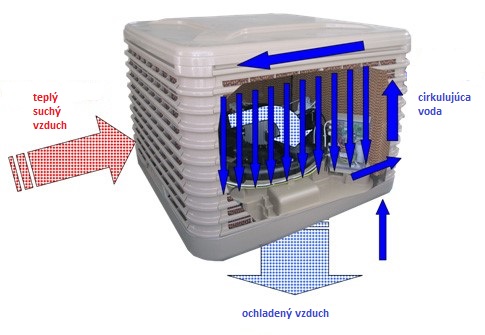Freon-free cooling
The principles of adiabatic cooling have been used since the beginning of time. Water as a natural cooling element, whether in passive form as ponds, reservoirs, canals, fountains or in active form, where its action additionally humidifies the air and thus removes excess heat by evaporation and thus cools the air. Evaporation is the most natural form of cooling and therefore also the most ecological. Direct humidification of fresh air is the most efficient way to produce maximum cooling capacity at minimal cost.
Each of us uses it, even though we often don't realize it. What other than evaporation does our skin use when we are warm. Sweat cools the surface and thus dissipates heat. Due to the huge area, there is a significant decrease and therefore an excellent result. We do the same locally in sports. In the middle of the summer heat, which of you has already tried to soak your T-shirt and put it on. If we add even a slight breeze, it can be paradoxically cold. We naturally use adiabatic cooling even in extreme situations, e.g. at an increased temperature, when we solve the temperature drop with wet wraps.
At the same time, it is an ecological way with a minimal burden on nature. Let us realize that in this case we can produce up to 25 kW of cooling capacity from 1 kW of electricity. What a ratio! Such production of cold is 4 to 10 times more energy efficient, depending on the real parameters derived from the climatic conditions at a given time. At the same time, we work with a huge mass of air to maximise this result. We can therefore say that we produce cold efficiently with a minimum carbon footprint. Huge electricity savings have a direct impact on our environment. Imagine all the CO2 that was not produced. Every evaporation unit that the customer prefers over standard air conditioning is a win for both the user and nature. We use fresh air and we filter it too. Its temperature drops by 10 to 12 ° C. If this means way lower investment and operating costs and at the same time does not destroy our planet, should be a clear choice.
This cooling does not have a power peak. It behaves equally and predictably. It does not burden the infrastructure system and does not create a stress on distribution and capacity. It does not force the user to create and order excessive performance reserves that are outside normal operating values. Do not change your energy strategy as you go to cover critical moments and avoid dependence on energy supplier policies.
Nature will thank us again if we do not have to change the cooling filling or cooling liquid in the system over time, which we should then dispose of in accordance with the regulations. Once again, we have saved the environment another blow. In addition, we talk about regular refrigerant changes. This saves our surroundings and our wallet many times over. How many times in your life do you have a chance to choose a more economical solution with higher efficiency, with a natural effect and at the same time with less impact on our planet? If only such clear decisions could be made more often.
A large volume of air, cleaned and cooled by 10 ° C, with minimal operating costs is what larger premises need, for which conventional air conditioning cannot be the solution.


